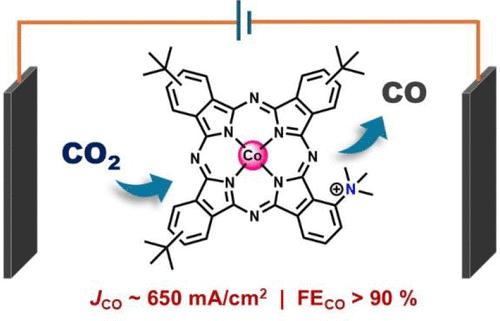分子催化剂使二氧化碳电还原在650毫安/平方厘米CO分电流密度
IF 18.2
1区 材料科学
Q1 CHEMISTRY, PHYSICAL
引用次数: 0
摘要
利用可再生电力将CO2电化学还原为CO为温室气体回收提供了一条引人注目的途径。双电子、双质子工艺因其操作简单和可扩展性而特别具有吸引力,随着该领域接近工业成熟,铜和银基纳米材料成为最广泛研究的催化剂。然而,实现实际应用所需的效率和稳定性仍然是一个重大挑战。最近,用碳基油墨固定在导电表面上的分子催化剂已经成为具有显著选择性的高度可调的杂化体系。在这项工作中,我们报告了一个简单的钴酞菁配合物,简单地用单个三甲基铵基团修饰,提供了出色的co2到CO的转化率和选择性,在中性ph下,在总电流密度为700 mA/cm2 (jCO = 650 mA/cm2)时达到93%的法拉第效率。值得注意的是,CO选择性超过90%在150 mA/cm2下持续超过42小时,说明了简单设计的分子催化剂在大规模应用中的潜力。本文章由计算机程序翻译,如有差异,请以英文原文为准。

Molecular Catalyst Enables CO2 Electroreduction at 650 mA/cm2 CO Partial Current Density
The electrochemical reduction of CO2 to CO using renewable electricity offers a compelling pathway for greenhouse gas recycling. The two-electron, two-proton process is particularly attractive due to its operational simplicity and scalability, with copper- and silver-based nanomaterials being the most widely studied catalysts as the field approaches industrial maturity. However, achieving the necessary efficiency and stability for practical applications remains a significant challenge. Recently, molecular catalysts immobilized on conductive surfaces with carbon-based inks have emerged as highly tunable hybrid systems capable of remarkable selectivity. In this work, we report that a straightforward cobalt phthalocyanine complex, simply modified with a single trimethylammonium group, delivers outstanding CO2-to-CO conversion rates and selectivity, reaching a Faradaic efficiency of 93% at a total current density of 700 mA/cm2 (jCO = 650 mA/cm2) at neutral pH. Notably, CO selectivity above 90% was sustained for over 42 h at 150 mA/cm2, illustrating the potential of simply designed molecular catalysts for large-scale applications.
求助全文
通过发布文献求助,成功后即可免费获取论文全文。
去求助
来源期刊

ACS Energy Letters
Energy-Renewable Energy, Sustainability and the Environment
CiteScore
31.20
自引率
5.00%
发文量
469
审稿时长
1 months
期刊介绍:
ACS Energy Letters is a monthly journal that publishes papers reporting new scientific advances in energy research. The journal focuses on topics that are of interest to scientists working in the fundamental and applied sciences. Rapid publication is a central criterion for acceptance, and the journal is known for its quick publication times, with an average of 4-6 weeks from submission to web publication in As Soon As Publishable format.
ACS Energy Letters is ranked as the number one journal in the Web of Science Electrochemistry category. It also ranks within the top 10 journals for Physical Chemistry, Energy & Fuels, and Nanoscience & Nanotechnology.
The journal offers several types of articles, including Letters, Energy Express, Perspectives, Reviews, Editorials, Viewpoints and Energy Focus. Additionally, authors have the option to submit videos that summarize or support the information presented in a Perspective or Review article, which can be highlighted on the journal's website. ACS Energy Letters is abstracted and indexed in Chemical Abstracts Service/SciFinder, EBSCO-summon, PubMed, Web of Science, Scopus and Portico.
 求助内容:
求助内容: 应助结果提醒方式:
应助结果提醒方式:


